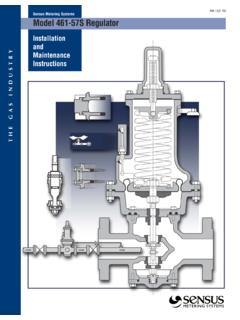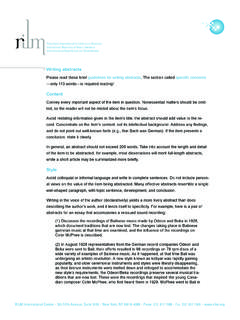Transcription of RM-1301 R7 Sensus Metering Systems Model 143-80 …
1 RM-1301 R7. Sensus Metering Systems Model 143-80 Service Regulator Installation and Maintenance I N D U S T R Y. Instructions The Model 143-80 is an excellent general purpose gas pressure regulator. It can be used for natural gas, air, CO2, propane, butane, nitrogen, and other gases. It can be used for gas services to homes, commercial establishments and small industries, for burners, unit heaters, boilers, and other equipment. Model 143-80 -1 is a standard regulator. The Model 143-80 -2 includes an internal relief valve. The 143-80 -2 is also available with a low pressure cut-off, designated as the Model 143-80 -6. Installation and Start-Up CAUTION: G A S. 1. Remove the shipping plugs from both the regulator inlet and Turn the gas on very slowly.
2 If an outlet stop is used, it should be outlet connections. opened first. Do not overload the diaphragm with a sudden surge 2. Make certain that the inside of the piping and the regulator of inlet pressure. Monitor the outlet pressure during start-up to inlet and outlet connections are clean. The connections must prevent an outlet pressure overload. T H E. be free of dirt, dope and other debris. 5. Turn the gas on very slowly. 3. Use pipe joint material only on the male threads of the pipe 6. For the Model 143-80 -6 Low Pressure Cut-off, remove cap (1). being connected to the regulator. Do not use pipe joint and pull up the diaphragm post to reset the LPCO valve. material on the female threads of the regulator.
3 7. Make certain that there are no leaks and that all connections 4. Install the regulator in the piping. Make certain that the gas are tight. flow through the regulator is in the direction as indicated by 8. Adjust outlet pressure (set point) by removing cap (1) and the arrow on the regulator body. turning adjustment spring button (2). Turn clockwise to The regulators may be installed in any position: right side up, increase and counter-clockwise to decrease outlet pressure. upside down, vertical piping, diagonal piping, etc., If required, Only adjust when gas is flowing through regulator. Be sure to the diaphragm case may be rotated 360 in any angle reinstall cap. increment. To rotate the 143-80 diaphragm case, loosen the CAUTION: coupling nut (12) and reposition the diaphragm case to It is the user's responsibility to assure that all regulator vents the desired position.
4 Retighten the coupling nut (12) to and/or vent lines exhaust to a non-hazardous location away from reseal the regulator. ANY POTENTIAL sources of ignition. Where vent lines are used, The diaphragm case vent (11) should be positioned to it is the user's responsibility to assure that each regulator is minimize the chances of moisture collecting on the vent side individually vented and that common vent lines ARE NOT used. of the diaphragm. 9. The vent connection is an escape path for the regulated gas. The diaphragm case vent must be positioned to protect Depending upon the type of gas, it could be flammable as with against flooding, rain, ice formation, traffic, tampering, etc. natural gas and propane. Therefore, the vent connection needs The vent must be protected against nest building animals, to be located and/or piped so that potential discharge occurs bees, insects, etc.
5 To prevent vent blockage and minimize the in a safe area away from buildings, open flames, collection chances for foreign material from collecting in the vent side of areas, arcing devices, etc. the regulator diaphragm. If required, the upper diaphragm Regulators that are installed indoors or in a non-vented area case (4) may be rotated by removing the upper-to-lower case must be vented to the outside. Run vent piping from the flange screws (10) and rotating the upper diaphragm case to regulator vent connection to a non-hazardous location on the the desired position. Reinstall the diaphragm flange screws outside away from any potential sources of ignition. and tighten to hold the diaphragm case in position and reseal.
6 For regulators equipped with internal relief valves (IRV), Models 143-80 -2, 143-80 -2HP and 143-80 -6, the vent piping must be vent connection size or larger and its length be as short and direct as possible to a safe area. This is to assure the venting of the internal relief valve discharge to the atmosphere without excessive pressure increase in the regulator and downstream piping. Continued on back. The outlet of the vent piping must allow for free and Over Pressurization Protection unobstructed passage of air and gas and must be protected Protection must be provided for the downstream piping system Continued on back. and the regulator's low pressure chambers to assure against against the potentials listed in instructions #4, #8 and #9.
7 The potential for over pressurization due to a regulator malfunction 10. For outdoor installations, it is recommended that the regulator or a failure of the regulator to lock up. The allowable over- be installed so that the regulator vent faces downward to avoid pressurization is the lowest of the maximum pressures permitted the potential for water and other foreign matter entering the by federal codes, state codes, Sensus Bulletin RDS-1498, regulator and interfering with the proper operation of the or other applicable standards. The methods of providing over- regulator. pressure protection could be a relief valve, a monitor regulator, a shut-off valve or similar device. CAUTION: Regulators are pressure control devices with numerous moving Buried Service parts subject to wear that is independent upon particular operating The Model 143-80 regulator is not recommended for buried conditions.
8 To assure continuous satisfactory operation, a periodic service. inspection schedule must be adhered with the frequency of inspection determined by the severity of service and applicable laws and regulations Temperature Limits The Model 143-80 regulator can be used for the flowing Servicing temperature of -20 F to 150 F ( C to C). 1. To access valve (7), orifice (6), or diaphragm assembly (8), first remove spring compression by unscrewing the spring cap Maximum Emergency Pressures (1) and spring adjustment ferrule (2). Remove spring (3) from The maximum pressure the regulator inlet may be subjected under regulator. abnormal conditions without causing damage to the regulator is: Maximum Inlet Pressure plus 50 psi.
9 For the Low Pressure 2. For access to the valve (7) and orifice (6), completely loosen Cut-off version, Model 143-80 -6 it is Maximum Inlet Pressure the coupling nut (12) and remove diaphragm case assembly plus 10 psi. from body (5). 3. To replace Buna-Nitrile valve pad (7), simply pull off of valve The maximum pressure to which the regulators case may be stem (9) and replace with new pad. subjected under abnormal conditions without causing damage to the internal parts is: Set point plus 3 psi. If the outlet pressure 4. To replace orifice (6), unscrew from body using a 1" hex exceeds this pressure, the regulator must be removed from service socket wrench thin-wall type. Apply sealant on threads of and carefully inspected.
10 Damaged or otherwise unsatisfactory orifice when installing replacement orifice. Re-screwing parts must be replaced before returning the regulator to service. replacement orifice must be installed at 50-60 ft-lbs. of torque. The maximum outlet pressure that can be safely contained in 5. To replace diaphragm assembly, remove flange screws (10). the diaphragm case is 10 psi (safely contained means no leakage and disassemble diaphragm assembly. Make certain all parts as well as no bursting.). are reassembled in their correct order and all threads and joints are tightened evenly and firmly. 6. Before reassembling body to diaphragm case, make certain that the o-ring is in position. 1. (See Sensus Bulletin TD-1301-LB for 143-80 -6 Low Pressure Cut-off Diagram).










